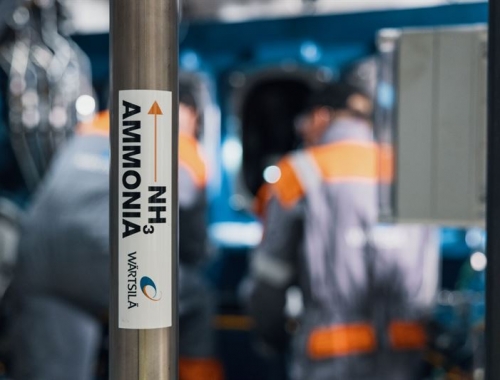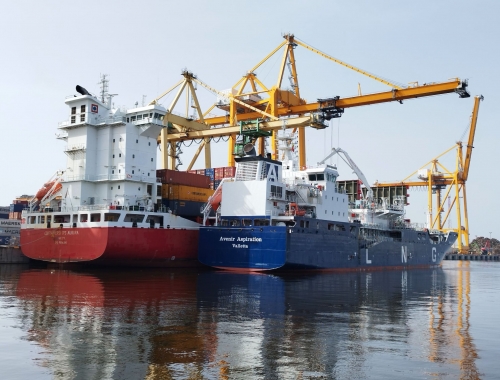Bright prospects for hydrogen in shipping
SUMMARY
Hydrogen has many advantages as a zero-carbon bunkering fuel for the maritime industry, but apart from some clear challenges arising from its physical characteristics, strong policy support is also needed for it to achieve success.
By Vincent WeeHydrogen is seen as one of the most promising alternative marine fuels and has been touted as the best solution to meeting the challenges of zero-carbon shipping.
While it does have significant advantages, the highly flammable gas also poses substantial challenges to adoption. Some of its properties make it ideally suited to meet the needs of the shipping industry as well as achieve its decarbonisation goals but a few key negative qualities remain as stumbling blocks to hydrogen's more widespread adoption.
Prime among these challenges are storage and fire hazard issues. In addition, to effectively compete with other low carbon fuels, the hydrogen industry's relatively inchoate state of development poses challenges in terms of availability and high production and transportation costs.
In summary, hydrogen is a colourless, odourless, tasteless, non-toxic, but highly combustible gas with a wide flammability range.
According to an ABS white paper, the budding alternative marine fuel has the highest energy content per mass of all chemical fuels at 120.2 MJ/kg compared to other marine fuels. And in terms of mass energy, it exceeds marine gas oil (MGO), the current commonly used greener fuelling option, by 2.8 times, and alcohols by five to six times.
Hydrogen has the potential to be a zero-carbon marine fuel when used in a fuel cell or a mono-fuel internal combustion engine. In a dual fuel combustion engine application, hydrogen can potentially significantly reduce carbon emissions with its low tank-to-wake emissions.
Drawbacks
Although using hydrogen as a fuel can increase engine efficiency and help reduce specific fuel consumption, on a volumetric basis however, due to its lower volumetric energy density, even liquid hydrogen may require four times more space than MGO or about two times more space than LNG for an equivalent amount of carried energy. Meanwhile, hydrogen's low liquefaction temperature of -253° C requires cryogenic storage equipment, which will need extra space.
All these add up to decreased cargo capacity or reduced range, both anathema to commercial vessel operators.
The other main issue is the safety concerns around hydrogen's flammable properties and wide flammability range, which increases when mixed with pure oxygen. Due to its low density, hydrogen leaks in open areas should dissipate quickly, but any leak in open or contained spaces can be a serious fire hazard due to the quick formation of a flammable gas mixture.
Enthusiasm
Nonetheless, the shipping industry, among others in heavy industry have jumped on the bandwagon, and governments and corporates have also shown enthusiasm in adopting the new fuel. Some highlights include national-level projects from countries such as India and Japan in the Asian region, as well as from European governments led by the Norwegians in particular who have long led the way with alternative fuel projects, including that for hydrogen.
India in January launched its National Green Hydrogen Mission, earmarking shipping as a key sector with $2.5mn budgeted for pilot projects. The South Asian giant will also aim to produce green hydrogen. Japan meanwhile was the first country to adopt a national hydrogen framework when it issued its Basic Hydrogen Strategy in 2017.
This has resulted in a relatively developed infrastructure as well as the strong involvement of Japanese corporates in the sector.
The strategy has focused on the development of hydrogen supply chains and both the government and companies are undertaking various projects. Kawasaki Heavy Industries for example, completed the world's first liquefied hydrogen transportation voyage in early 2022 and is on track to meet its ambitions of building a global hydrogen supply chain. In Europe, the use of hydrogen in the maritime sector has been elevated to European Union-wide policy level with numerous projects already well established. Norwegian projects such as the Norled-operated MF Hydra passenger ferry and Wilhelmsen Group-affiliated Topeka cargo/liquefied hydrogen carrier concept vessels are leading the way.
Port level projects are being driven by various key bunkering and commodities trading ports such as Rotterdam and Singapore as well as Antwerp and Amsterdam. Much of the efforts on this front are centred on developing both fuel supply infrastructure as well as the supply chain.
Singapore in 2022 officially launched its national hydrogen strategy and called for proposals to build, own and operate low or zero-carbon power generation and bunkering solutions.
Rotterdam has declared its ambition to be Europe's hydrogen hub with Shell being roped in to build its its 200-MW Hydrogen Holland I project to produce green hydrogen while supply agreements have been signed with a wide range of global partners, including Singapore and major Middle East partners such as AD Ports and Aramco. Europe's top bunkering port has also announced extensive plans to boost hydrogen supply connectivity across Europe. Its own HyTransPort dedicated pipeline will serve the port as well as connect to the Delta Corridor, an expansive pipeline system serving northwest Europe, linking the Port of Rotterdam to the rest of the Netherlands, Port of Antwerp, and the industrial Rhine region in Germany and will be operational in 2026.
In Germany, in line with aims to create 10 GW of domestic electrolysis capacity for green hydrogen by 2040, oil major BP is assessing the feasibility of a new 130,000 metric ton/year hydrogen hub at Wilhelmshaven in Germany set to begin operations in 2028.
Meanwhile large shipping companies are also coming up with their own projects such as major South Korean shipbuilder Hyundai Heavy Industries' Maritime Hydrogen Vision and leading Chinese shipping company Cosco Shipping's very business-oriented plan to offer carbon-neutral supply services that can be certificated, measured and traced as well as plans to work with other Chinese companies on the domestic production of green marine fuels.
Infrastructure critical
The key to the widespread adoption of hydrogen or any other alternative fuel for that matter lies in the infrastructure to supply it to vessels, and herein lies the rub.
The states of development of the various infrastructure and the supporting tax and incentive structures to make this work vary widely. Yet, the path to creating the conditions for these to develop is far from straightforward.
It is clear that for hydrogen bunkering to work, the development of facilities at ports will need support from governments and policies that can reduce the cost of hydrogen production, distribution and acquisition must be put in place. This must also be balanced with the ability of the fuel to actually reduce emissions while the question of on what basis is another key issue that needs to be addressed.
According to the Center for Strategic and International Studies, highly carbon-intensive grey hydrogen is currently reasonably price competitive with traditional fuel sources, costing around $1-2/kg of H2, but does not offer a sustainable solution on a well-to-wake basis. Blue hydrogen is 30%–80% more expensive than grey hydrogen, and green hydrogen is about four times costlier than grey hydrogen.
"While the retail prices of blue and green hydrogen are expected to decline as the cost of renewable electricity and electrolysis fall, government intervention is necessary to promote private investment in green hydrogen technology and to develop infrastructure for refuelling and hydrogen transportation necessary for blue and green hydrogen to be price competitive with grey hydrogen," CSIS reiterates.
Meanwhile, US non-profit organisation Resources for the Future found that a carbon tax or tax credit of $50/mt of CO2 would make blue hydrogen price competitive with grey hydrogen. This is corroborated in a Bureau Veritas white paper, which says that access to renewable electricity on a large scale will be key to produce e-fuels and hydrogen, and a cross-sector approach will be needed to share resources such as wind and solar power between maritime and other sectors. BV also addresses the issue of incentives, including legislation and market-based measures.
Among the measures being developed by regional and global regulators, current EU ETS and FuelEU Maritime proposals especially could result in significant levels of taxation and penalties for the maritime industry.
But the gap between ambition and action remains a challenge. While a 2021 Global Maritime Forum study found that nearly half of 106 projects looking at zero emissions in maritime shipping worldwide focused on hydrogen, a 2022 report from the Tyndall Centre at the University of Manchester showed that just 4% of publicly announced green hydrogen projects are actually being fully funded.
Bright prospects
The prospects for hydrogen as a bunkering fuel remain bright however. Demand drivers continue to provide support, with shipping industry initiatives such as the Getting to Zero Coalition and Cargo Owners for Zero Emission Vessels playing an important role.
The parallel establishment of green corridors that is essential for these initiatives to succeed continues apace. The Australia-Japan green corridor is seeing progress while Rotterdam has signed a host of deals with countries ranging from Brazil to the Middle East.
The 70mn mt/yr existing global hydrogen market is a big advantage and the big lead that the US has which could be extended with new incentives can play a big part in providing affordable hydrogen to the maritime market.
A 2020 International Council on Clean Transportation study found that the cost of producing green hydrogen from renewable electricity in the US and Europe could be halved by 2050 with financial incentives to promote research and development.
The use of hydrogen as an alternative fuel to help the maritime industry decarbonise is full of potential as well as challenges. While some of the technical issues can be overcome with proper regulation and safety protocols, market-based challenges will need more determined policy support to be overcome.








